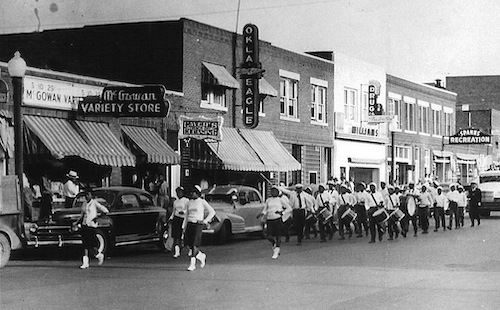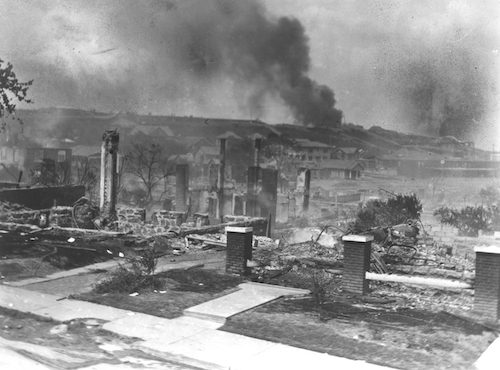Communiqué
One of the worst racially-motivated massacres in the nation’s history, “Goin’ Back to T-Town” on AMERICAN EXPERIENCE – May 23 at 9 pm
< < Back to one-of-the-worst-racially-motivated-massacres-in-the-nations-history-goin-back-to-t-town-on-american-experience-feb-8-at-9-pmGoin’ Back to T-Town, Portrait of a Once-Thriving Black Community in Tulsa on
American Experience – Tuesday, May 23 at 9 pm
2021 Marked Centennial of the 1921 Racially-Motivated Massacre in Tulsa, Oklahoma
Goin’ Back to T-Town, produced by Sam Pollard and Joyce Vaughn, tells the story of Greenwood, an extraordinary Black community in Tulsa, Oklahoma, that prospered during the 1920s and 30s despite rampant and hostile segregation. Torn apart in 1921 by one of the worst racially-motivated massacres in the nation’s history, the neighborhood rose from the ashes, and by 1936 boasted the largest concentration of Black-owned businesses in the U.S., known as “Black Wall Street.” Ironically, it could not survive the progressive policies of integration and urban renewal of the 1960s. Told through the memories of those who lived through the events, the film is a bittersweet celebration of small-town life and the resilience of a community’s spirit. Narrated by Ossie Davis, Goin’ Back to T-Town was first broadcast in 1993.

“Over 32 seasons, American Experience has produced an amazing archive of films that documents various chapters of our country’s complicated history,” said Cameo George, American Experience executive producer. “Goin’ Back to T-Town is a film that was made for the series nearly three decades ago and yet it is shockingly relevant today. The story of the 1921 Tulsa race massacre was hidden for generations, but as of last year, forensic experts began searching for the mass graves of Black Tulsa citizens who were killed by white mobs. This film features some of the last recorded eyewitness accounts from survivors of that atrocity. Being able to pull this film out of the American Experience vault for rebroadcast is a special opportunity and a reminder of the unique legacy of the series.”
Even before the Civil War, African Americans — some free and some enslaved by Native Americans — were settling in the territory of Oklahoma. By the turn of the century, Black communities began to dot the landscape — more than 27 by the early 1900s. But none were as extraordinary as Greenwood in Tulsa.

When Oklahoma became a state in 1907, the all-white legislature passed laws designed to keep Blacks separate and in their place: schools, hospitals, businesses, even telephone booths were segregated. But seven years earlier, a group of Black businessmen had purchased a small piece of land in the northeastern section of Tulsa. They called it Greenwood, and as segregation grew in white Tulsa, Black businesses — and Black life — thrived there.
But no one could have foreseen what would happen on the night of May 31, 1921, after newspapers falsely reported that a Black man had attacked a white woman in an elevator. When angry whites gathered outside the courthouse where the accused was being held, Black residents came out to prevent a lynching. A scuffle broke out and shots were fired. Rioting ensued, and a white mob looted and burned Greenwood to the ground.
When the night was over, city officials put the death toll at 36; newspapers listed almost 100 deaths. But the Red Cross reported more than 300 people had been killed. More than 35 blocks of Tulsa’s Black community had burned, and over 4,000 people were left homeless. The search for remains of additional victims continues to this day.
Undaunted, the people of Greenwood refused to leave. Black citizens began to rebuild a new Greenwood from the ashes, making it stronger and more alive than ever. By 1936, businesses flourished once again on “Black Wall Street.” Although racial discrimination continued, inside Greenwood citizens supported one another in the once again vibrant community.
Ironically, Greenwood, which fought its way back from the racial violence of the 1920s, couldn’t survive the progressive policies of integration and urban renewal of the 1960s. After the 1954 Brown v. Board of Education decision outlawed segregation in public schools, integration slowly came to Tulsa. White businesses competed for Black customers, hurting the neighborhood. But the final blow came when a new expressway was built through the heart of Greenwood, cutting the community in two. Its business establishments never recovered.
“I don’t think racial segregation is a good thing,” Greenwood resident Jim Goodwin says in the film. “But the quality of our lives, in many respects, was better in the days of segregation, and the challenge today is to make it as good or better.”
Goin’ Back to T-Town
| Produced by | SAM POLLARD
JOYCE VAUGHN |
|
| Written by | CARMEN FIELDS | |
| Narrated By
Edited by Cinematography |
OSSIE DAVIS
BETTY CICCARELLI ROBERT SHEPARD |
|
| Sound | SEKOU SHEPARD
|
A two dollars and a dream, inc. production for American Experience
American Experience is a production of GBH Boston
| Executive Producer | CAMEO GEORGE |

